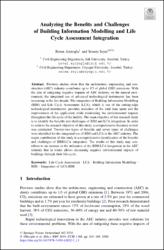| dc.contributor.author | Azizoğlu, Heval Botan | en_US |
| dc.contributor.author | Seyis Kazazoğlu, Senem | en_US |
| dc.date.accessioned | 2020-04-13T07:10:50Z | |
| dc.date.available | 2020-04-13T07:10:50Z | |
| dc.date.issued | 2020 | |
| dc.identifier.citation | Azizoğlu, H. B., Seyis Kazazoğlu, S. (2020). Analyzing the benefits and challenges of building information modelling and life cycle assessment integration. Paper presented at the 161-169. doi:10.1007/978-3-030-42852-5_13 | en_US |
| dc.identifier.isbn | 9783030428518 | |
| dc.identifier.issn | 1865-0929 | |
| dc.identifier.uri | https://hdl.handle.net/11729/2296 | |
| dc.identifier.uri | http://dx.doi.org/10.1007/978-3-030-42852-5_13 | |
| dc.description.abstract | Previous studies show that the architecture, engineering and construction (AEC) industry contributes up to 1/3 of global GHG emissions. With the aim of mitigating negative impacts of AEC industry on the natural environment, the integrated use of advanced technological instruments has been increasing in the last decade. The integration of Building Information Modelling (BIM) and Life Cycle Assessment (LCA), which is one of the cutting-edge technological instruments, provides reduction of the total time spent and the improvement of the application while minimizing the environmental impacts throughout the life cycle of the facility. The main objective of this research study is to identify the benefits and challenges of BIM and LCA integration. In order to achieve the research objective of this study, a comprehensive literature review was conducted. Twenty-two types of benefits and seven types of challenges were identified for the integrated use of BIM and LCA in the AEC industry. The major contribution of this study is a comprehensive identification of the benefits and challenges of BIM-LCA integration. The results of this study may contribute to an increase in the utilization of the BIM-LCA integration in the AEC industry that in return allows decreasing negative environmental impacts of buildings through their life-cycle. | en_US |
| dc.language.iso | eng | en_US |
| dc.publisher | Springer | en_US |
| dc.relation.isversionof | 10.1007/978-3-030-42852-5_13 | |
| dc.rights | info:eu-repo/semantics/closedAccess | en_US |
| dc.subject | Architectural design | en_US |
| dc.subject | Architecture , engineering and construction industries | en_US |
| dc.subject | BIM | en_US |
| dc.subject | Building information modelling | en_US |
| dc.subject | Environmental impact | en_US |
| dc.subject | Greenhouse gases | en_US |
| dc.subject | Information theory | en_US |
| dc.subject | Integrated use | en_US |
| dc.subject | Integration | en_US |
| dc.subject | Integration of LCA-BIM | en_US |
| dc.subject | LCA | en_US |
| dc.subject | Life cycle | en_US |
| dc.subject | Life cycle assessment | en_US |
| dc.subject | Life cycle assessment (LCA) | en_US |
| dc.subject | Literature reviews | en_US |
| dc.subject | Natural environments | en_US |
| dc.subject | Research objectives | en_US |
| dc.subject | Research studies | en_US |
| dc.title | Analyzing the benefits and challenges of building information modelling and life cycle assessment integration | en_US |
| dc.type | conferenceObject | en_US |
| dc.description.version | Publisher's Version | en_US |
| dc.relation.journal | Communications in Computer and Information Science | en_US |
| dc.contributor.department | Işık Üniversitesi, Mühendislik Fakültesi, İnşaat Mühendisliği Bölümü | en_US |
| dc.contributor.department | Işık University, Faculty of Engineering, Department of Civil Engineering | en_US |
| dc.identifier.volume | 1188 | |
| dc.identifier.startpage | 161 | |
| dc.identifier.endpage | 169 | |
| dc.peerreviewed | Yes | en_US |
| dc.publicationstatus | Published | en_US |
| dc.relation.publicationcategory | Konferans Öğesi - Uluslararası - Kurum Öğretim Elemanı | en_US |
| dc.contributor.institutionauthor | Azizoğlu, Heval Botan | en_US |
| dc.relation.index | Scopus | en_US |



















